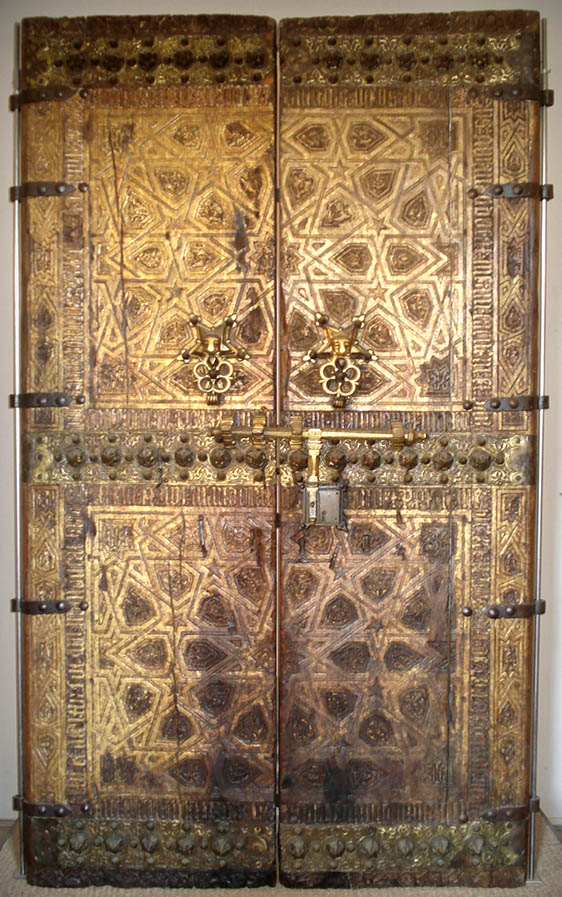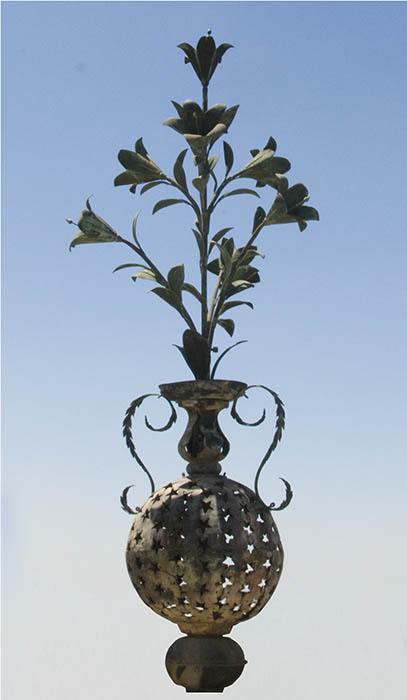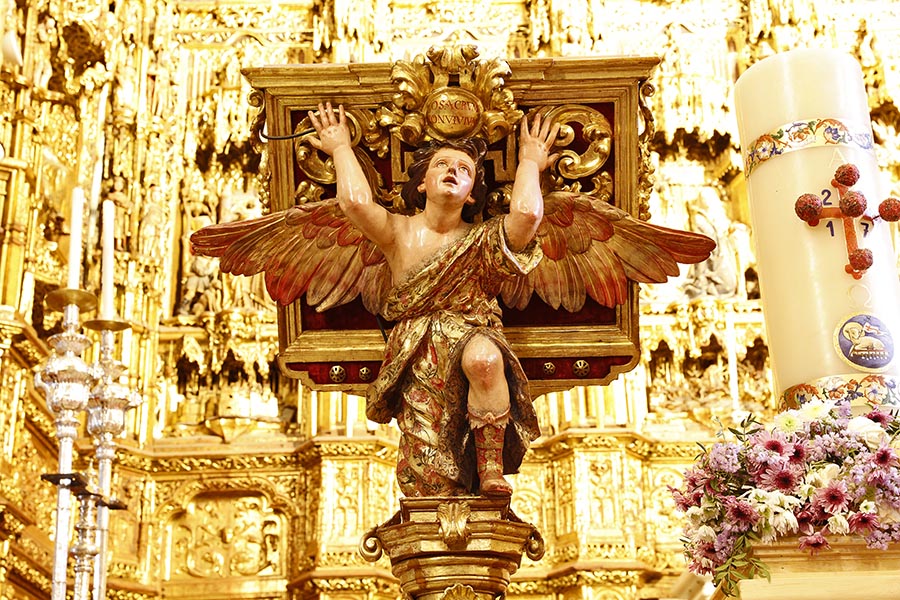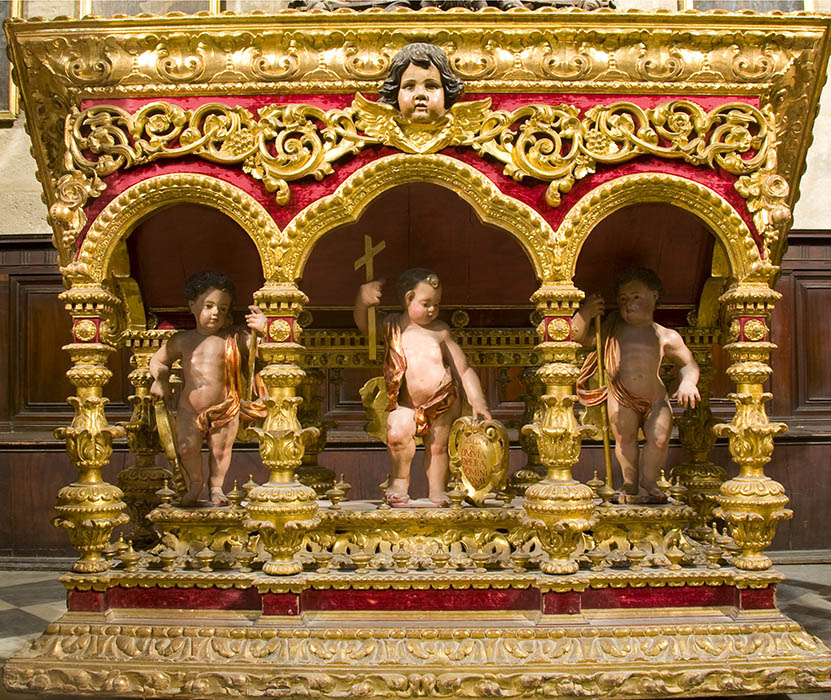
ANONIMO, Siglo XIV
Cámaras de la Giralda

Fernando MARMOLEJO, Siglo XX
Torre de la Giralda

Francisco Antonio GIJÓN, Siglo XVII
Capilla Mayor

Francisco Antonio GIJÓN, 1723
Capilla de la Virgen del Pilar




IN THIS SECTION:
Decorative Arts
Themovable heritage of the Cathedral of Seville includes the choir stalls of the main altar and the Royal Chapel, the Baroque set of the portable choir of the Corpus Christi, other liturgical furnishings, door casements, cabinets and, among others, protocol chairs.
The oldest preserved works are the doors of the Puerta del Perdón and those of another door that was located in the Sagrario chapel of the primitive Mudejar Cathedral. The first ones are Almohad work plated with knockers and cast bronze plates; the second of gilded wood are a reference among their Mudejar contemporaries, made in Toledo and Seville in the mid-fourteenth century.
The monumental choir stalls of the main chapel consist of one hundred and seventeen seats, high and low, made by Nufro Sánchez and Pieter Dancart between 1464 and 1479; reformed in 1511 and underwent a major restoration at the end of the nineteenth century. The backs of the high seats are Mudejar lacquer panels and the lower ones have reliefs of the Old and New Testament. The iconography is completed by an ample program of prophets, apostles and saints located in the interspaces and upper part of the canopy, together with the allegorical motifs of the mercies.
The monumental choir lectern is a renaissance work in wood and bronze made by Juan Marín, Bartolomé Morel, Francisco Hernández, Juan del Pozo and Bautista Vázquez, el Viejo; the reliefs in the lower part illustrate historical aspects of the furnishings, instruments and music of the Cathedral of Seville during the time of the chapel master Francisco Guerrero (1549-1599). Works from the same period are the Renaissance reliefs preserved from the drawers of the Main Sacristy and the door casements of the door of the same area carved by Diego Guillent Ferrant, Diego de Velasco el Mozo, Juan Bautista Vázquez el Viejo, Alonso Ruiz, Cornielles and Jerónimo de Valencia between 1548-1551. In the Chapter House, the archbishop’s chair made by Diego de Velasco and Andrés de Ocampo in 1592 is preserved, as well as the seat of the secretary of the Cabildo.
Collaboration and commissions to sculptors for the Cathedral’s furnishings continued during the Baroque period. Pedro Duque Cornejo carved in 1743 the reliefs of the large cupboards that keep the different pieces that make up the silver altar and trousseau, placed in the access space to the main sacristy. The most important set of the baroque period is the portable furniture for sacramental celebrations: the monumental lecterns of gilded and polychrome wood for the cantorales and the altar, attributed to the sculptor Francisco Antonio Gijón at the end of the 17th century.
Of the baroque and rococo furnishings, of note are the gilded benches and seats made by chapter agreement in 1777 for the Corpus Christi and Holy Thursday festivities, two gilded wooden archiepiscopal seats, a set of Spanish armchairs from the 18th century, several hip chairs covered in red velvet, two gilded wooden consoles and two baroque confessionals. The doors of the choir loft that give access to the organ boxes are the work of Luis de Figueroa (1633), the doors of the doors of the presbytery of the Antigua chapel and those of the access porches to the choir made of ebony, tortoiseshell and inlaid bronze correspond to the third decade of the eighteenth century.
Neoclassical works are the choir stalls and lectern of the choir of the Royal Chapel paid for by Charles IV and the cabinets of the old Accounts Room (1790). The two neo-Gothic transept arches were built at the beginning of the 20th century.
Grid
The grilles of the Cathedral of Seville are an extraordinary set to observe the stylistic evolution of the art of grillwork in Andalusia. These enclosures protect the enclosures, constitute openwork screens through which light penetrates and produce an atmosphere of mystery that modifies, enhances and transforms the spaces of worship and prayer. Funded by the Cabildo and by private individuals who had endowed chaplaincies, their close relationship with architecture determined the direct participation of the Maestro Mayor, who provided designs and drawings for their construction on numerous occasions.
The lack of nearby deposits made it necessary to import iron, which was traded by merchants from Biscay and Guipuzcoa. The masters who made the gratings of the Cathedral had their workshops and houses for rent in rooms near the Corral de San Miguel, in front of the steps of the temple, or in the Postigo del Carbón, near the River and the Atarazanas. The large size of the grilles of the High Altar and choir led to their construction in some rooms of the Alcazar.
Sancho Muñoz and Fray Francisco de Salamanca introduced the technical innovations of 16th century wrought ironwork in the diocese. With his collaborators they built the choir grille (1518-1523), which was seriously damaged in 1888, and the two lateral ones of the main altar (1518-1523). The main grille, designed by Bartolomé de Jaén, is the work of Fray Francisco de Salamanca and Juan de Ávila, who also designed the pulpits (1524-1533).
Most of the 16th century altars still have their contemporary grilles and railings. The altar of the altar of the Pietà is attributed to these masters and the others follow designs by the architects Hernán Ruiz II, Martín de Gainza and Miguel de Zumárraga. Pedro Delgado, from Salamanca, documented from 1535 to 1571, made the grilles of the chapels of the Mariscal and the chantre under the direction of the former. Luis de Medina, de Scalas and that of the Star (1568), which served as a model in the 17th century for the other three alabaster chapels.
The slow execution of the grille of the Antigua chapel required successive interventions by the masters Juan López, Juan Barba and Rodrigo de Segovia (1565 – 1601). The fence
From the 17th century, the monumental grille of the chapel of La Concepción, made by Pedro Muñoz and polychromed by Juan de Valdés in 1654, inspired in 1778 the one made by Fray José Cordero for the chapel of San Pedro. Charles III donated the grille of the Royal Chapel designed by Sebastián van der Brocht and crowned by a group of the sculptor Jerónimo Roldán (1773). The chapels of San Laureano, del Pilar, San Leandro and San Isidoro have 18th century grilles. From the 20th century, the neo-Gothic grilles of the chapels of San Andrés and Evangelistas stand out.
Ceramics
The preserved documentation shows numerous ceramic orders, made by private individuals or by the Chapter, not only to cover the fronts of the endowed altars and tombs, but also to pave the chapels, the choir, the courtyards and, among others, glazed ceramic covering of the dome in 1508-1511, the lantern of the main sacristy (1543) or the dome of the Royal Chapel (1583).
This information contrasts with the scarce testimonies preserved. Archaeological work has revealed the character of the pavement of the square ceramic slabs from the Almohad mosque, the rectangular ones of the gothic paving together with other testimonies of sepulchral tiles from the 14th century that represent glazed heraldic elements, made with molds and were very common in contemporary burials.
In the Mudejar Cathedral there were numerous altars covered with ceramics, which were generalized in the Gothic building at the end of the 15th and 16th centuries with groin or basin tiles. The front of the sacristy of the Chapel of the Maidens has preserved a good example of this technique; attributed to the workshop of the Pulido brothers, active in Seville in the third decade of the 16th century, it has decorative elements that imitate a medieval weave, combined with the coat of arms of García de Gibraleón, patron of the chapel.
These ceramic fronts had a perimeter band that enclosed the decorative front with figures alluding to the dedication of the altar or its patron saints, between two rectangular lateral falls. The decorative cloths imitating fabrics were maintained in the Sevillian tradition during the Baroque period and later inspired the historicists generalized in the workshops of Triana at the end of the 19th century. José Gestoso designed the pediments of the altar of the Encarnación and the chapel of the Inmaculada, made by the ceramists Manuel Ramos (1909) and Manuel Amores (1908), respectively.
The baroque flooring of the Cathedral at the end of the 18th century and the neoclassical transformations of the following century eliminated most of the ceramic coverings of the altars, which were reformed with jasper and wood imitating marble. However, the plain tiles with vegetal decoration, arranged in a checkerboard pattern, of the altar of the Assumption and the Renaissance flooring that still covers the patio of the Mariscal (ca. 1591) remain.